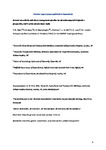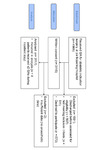General anaesthetic and airway management practice for obstetric surgery in England: a prospective, multi-centre observational study
| dc.contributor.author | Odor, P | |
| dc.contributor.author | Bampoe, S | |
| dc.contributor.author | Moonesinghe, R | |
| dc.contributor.author | Andrade, Jackie | |
| dc.contributor.author | Pandit, J | |
| dc.contributor.author | Lucas, N | |
| dc.date.accessioned | 2020-07-20T16:42:00Z | |
| dc.date.issued | 2020-09-21 | |
| dc.identifier.issn | 0003-2409 | |
| dc.identifier.issn | 1365-2044 | |
| dc.identifier.uri | http://hdl.handle.net/10026.1/16084 | |
| dc.description.abstract |
<jats:title>Summary</jats:title><jats:p>There are no current descriptions of general anaesthesia characteristics for obstetric surgery, despite recent changes to patient baseline characteristics and airway management guidelines. This analysis of data from the direct reporting of awareness in maternity patients’ (DREAMY) study of accidental awareness during obstetric anaesthesia aimed to describe practice for obstetric general anaesthesia in England and compare with earlier surveys and best‐practice recommendations. Consenting patients who received general anaesthesia for obstetric surgery in 72 hospitals from May 2017 to August 2018 were included. Baseline characteristics, airway management, anaesthetic techniques and major complications were collected. Descriptive analysis, binary logistic regression modelling and comparisons with earlier data were conducted. Data were collected from 3117 procedures, including 2554 (81.9%) caesarean deliveries. Thiopental was the induction drug in 1649 (52.9%) patients, compared with propofol in 1419 (45.5%). Suxamethonium was the neuromuscular blocking drug for tracheal intubation in 2631 (86.1%), compared with rocuronium in 367 (11.8%). Difficult tracheal intubation was reported in 1 in 19 (95%CI 1 in 16–22) and failed intubation in 1 in 312 (95%CI 1 in 169–667). Obese patients were over‐represented compared with national baselines and associated with difficult, but not failed intubation. There was more evidence of change in practice for induction drugs (increased use of propofol) than neuromuscular blocking drugs (suxamethonium remains the most popular). There was evidence of improvement in practice, with increased monitoring and reversal of neuromuscular blockade (although this remains suboptimal). Despite a high risk of difficult intubation in this population, videolaryngoscopy was rarely used (1.9%).</jats:p> | |
| dc.format.extent | 460-471 | |
| dc.format.medium | Print-Electronic | |
| dc.language | en | |
| dc.language.iso | en | |
| dc.publisher | Wiley | |
| dc.subject | obstetrics | |
| dc.subject | general anaesthesia | |
| dc.subject | caesarean section | |
| dc.subject | airway management | |
| dc.title | General anaesthetic and airway management practice for obstetric surgery in England: a prospective, multi-centre observational study | |
| dc.type | journal-article | |
| dc.type | Journal Article | |
| dc.type | Multicenter Study | |
| dc.type | Observational Study | |
| plymouth.author-url | https://www.webofscience.com/api/gateway?GWVersion=2&SrcApp=PARTNER_APP&SrcAuth=LinksAMR&KeyUT=WOS:000571439800001&DestLinkType=FullRecord&DestApp=ALL_WOS&UsrCustomerID=11bb513d99f797142bcfeffcc58ea008 | |
| plymouth.issue | 4 | |
| plymouth.volume | 76 | |
| plymouth.publication-status | Published | |
| plymouth.journal | Anaesthesia | |
| dc.identifier.doi | 10.1111/anae.15250 | |
| plymouth.organisational-group | /Plymouth | |
| plymouth.organisational-group | /Plymouth/Admin Group - REF | |
| plymouth.organisational-group | /Plymouth/Admin Group - REF/REF Admin Group - FoH | |
| plymouth.organisational-group | /Plymouth/Faculty of Health | |
| plymouth.organisational-group | /Plymouth/Faculty of Health/Peninsula Medical School | |
| plymouth.organisational-group | /Plymouth/Faculty of Health/School of Psychology | |
| plymouth.organisational-group | /Plymouth/REF 2021 Researchers by UoA | |
| plymouth.organisational-group | /Plymouth/REF 2021 Researchers by UoA/UoA01 Clinical Medicine | |
| plymouth.organisational-group | /Plymouth/REF 2021 Researchers by UoA/UoA04 Psychology, Psychiatry and Neuroscience | |
| plymouth.organisational-group | /Plymouth/REF 2021 Researchers by UoA/UoA04 Psychology, Psychiatry and Neuroscience/UoA04 REF peer reviewers | |
| plymouth.organisational-group | /Plymouth/Research Groups | |
| plymouth.organisational-group | /Plymouth/Research Groups/Centre for Brain, Cognition and Behaviour (CBCB) | |
| plymouth.organisational-group | /Plymouth/Research Groups/Centre for Brain, Cognition and Behaviour (CBCB)/Cognition | |
| plymouth.organisational-group | /Plymouth/Research Groups/Institute of Health and Community | |
| plymouth.organisational-group | /Plymouth/Research Groups/Plymouth Institute of Health and Care Research (PIHR) | |
| plymouth.organisational-group | /Plymouth/Users by role | |
| plymouth.organisational-group | /Plymouth/Users by role/Academics | |
| dc.publisher.place | England | |
| dcterms.dateAccepted | 2020-06-23 | |
| dc.rights.embargodate | 2020-10-16 | |
| dc.identifier.eissn | 1365-2044 | |
| dc.rights.embargoperiod | Not known | |
| rioxxterms.versionofrecord | 10.1111/anae.15250 | |
| rioxxterms.licenseref.uri | http://www.rioxx.net/licenses/all-rights-reserved | |
| rioxxterms.licenseref.startdate | 2020-09-21 | |
| rioxxterms.type | Journal Article/Review |



